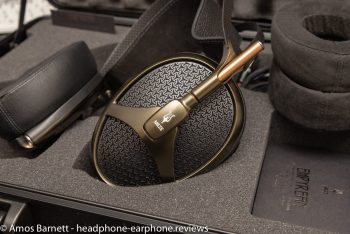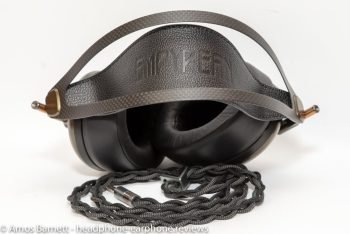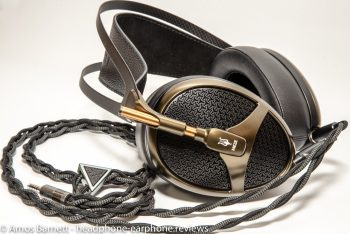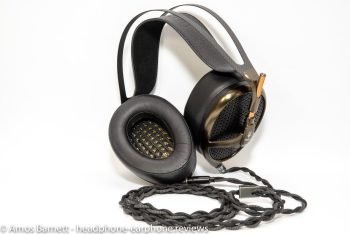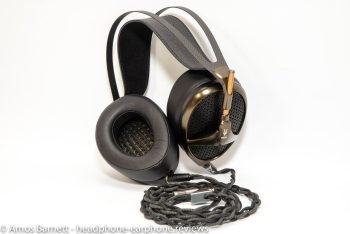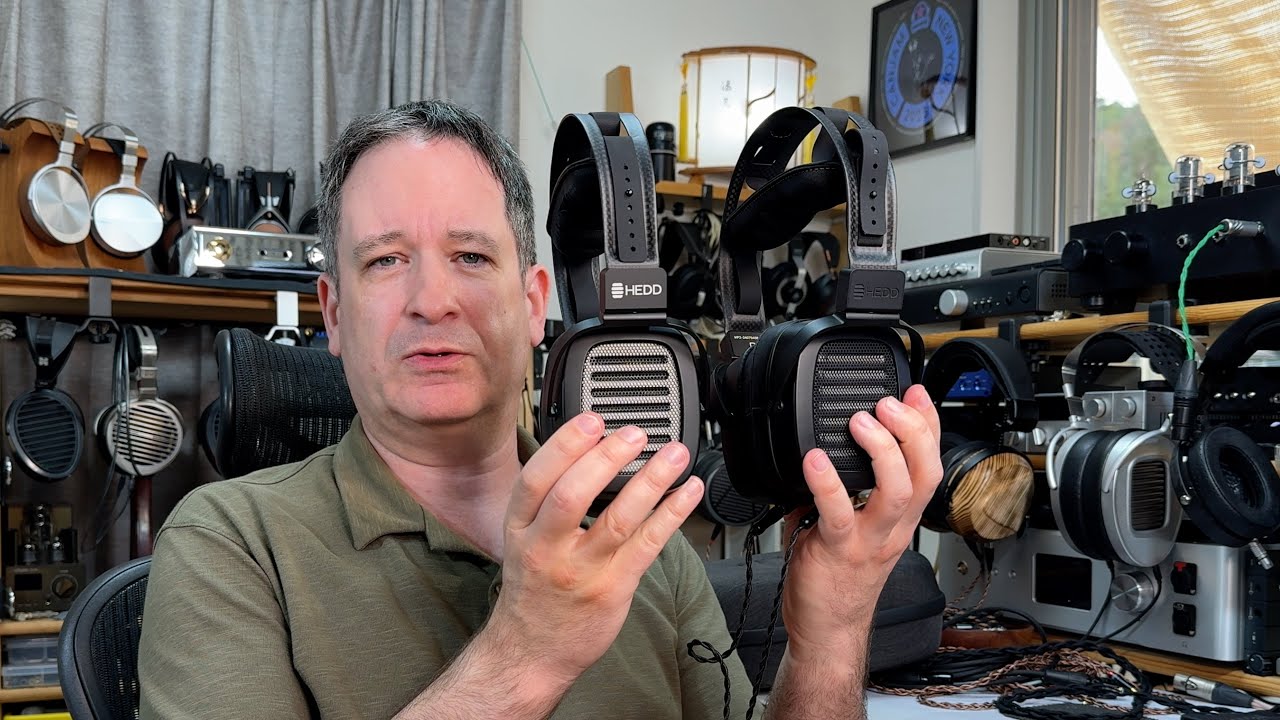If someone had told me a few years ago that an unknown man from Romania would come out with one of the world’s best high-end headphones, I wouldn’t have believed it. But as I’m sitting here listening with the Empyrean and I think that Antony Meze may have just achieved what many others have aimed for, but didn’t quite reach, at least not without some kind of compromise.
The Empyrean arrived in what would most easily be described as a suitcase inside a cardboard box. Inside, along with the headphones there is a fairly standard cable, which I’d describe as being “Sony-like” — up to the splitter is cloth, then a rubber coating up to the plugs. Headphone-end connectors, rather conveniently, are 4-pin mini-XLR in the manner of Audeze.
A short guide, with specifications, a warning not to press on the outside grills and guide to not listening too loud, come with a card signed by Antony Meze with a short note, as well as a card with the serial number. A pair of Alcantra earpads are also included.
Design
It is immediately apparent upon first handling the Empyrean that Meze and Rinaro have gone to great lengths to perfect the design. Whereas, say, my Focal Utopias are beautifully made, they don’t look another $2.5k more expensive than the Clear. Nor the HiFiMan Susvara, which doesn’t look $3k more than a HE1000 V2.
The Empyrean, on the other hand, in both design and attention to detail really looks like what you’d expect a $3000 pair of headphones to look like, even if spending that amount on a pair of headphones would be crazy to a lot of people.
Suspended from a single-piece carbon fibre arc, reminiscent of that on the 99 Classic, precision CNC-machined parts, from yoke to cup, provide the mechanism. Rather than polished completely smooth, subtle machining marks have been left on the cups themselves, giving them a unique, very slight texture.
Vertical fit is managed through two hidden springs behind the Meze logo, and both cups swivel on a Grado-like pole via a quite stiff rubber bearing. Adjusting fit requires two hands and some firm pulling, pushing and wiggling. Afterwards the rubber holds them sufficiently firmly that I could hold them sideways, turn a cup, and it would stay in the position I left it. That also means that it is possible to give the drivers a deliberate angle while they are on your head, and they will stay where they are put.
Both sets of ear-pads attach magnetically, with a small amount of friction added, which holds them in place quite well. Uniquely, it uses the array magnets to do this. The ear-pads themselves are over 30mm deep and have a shape intended to minimise the size of the acoustic chamber around the ear while maintaining a shape that is close to the shape of an ear.
Another unique feature is that the back of the ear-pads have metal grills designed to reduce stray magnetic fields, reflecting them back. Meze claims that this increases the output by around 1dB.
The head-pad is another area where Meze have been clever. Rather than just have a regular head-pad suspended between both sides, the contact ends are stiffened and have been bent in reverse so as to increase the contact area over one’s head for comfort. This can be adjusted as required with a bit of finger pressure.
In total, this results in what I would describe as “better than Sony” levels of comfort.

The driver itself is made by Rinaro in the Ukraine. Uniquely, while most planar drivers either use a weaving horizontal trace (such as Audeze and HiFiMan) or a round trace (such as classic Yamaha models or the discontinued Oppo models) the Empyrean uses a combination of both. The round trace is intended to be most ideal for higher frequencies, while the curved traces above it are designed for the lower frequencies. The magnet array, which looks like the spreading ripples caused by a drop in water, perfectly match the gaps between the driver traces.
Sound
A simple summary of the sonic attributes of the Empyrean would be that they are a very resolving version of the 99 Classic, the improvement as much in sound as in materials.
The longer description is where things get more interesting. Like the 99 Classic, the Empyrean has what I’ve termed a “consumer tuning”, a bit warm of neutral, the frequency response overall even, but with the treble somewhat muted compared to other headphones like the HiFiMan Susvara or Focal Utopia.
Jude Mansilla’s measurements, uncompensated for how our ears attenuate mid-range frequencies, have them as flat through from the bass to the mid-range. From there they have a hump from 2 kHz that counters our ears’ attenuation, but then the treble peak doesn’t go as high as the Sennheiser HD800S does at 6kHz. Nor do they have a peak in the 8-10 kHz range as other headphones have, which gives instruments a sense of “air”, unless your hearing null matches the peak.
However, far from making them sound slow, the unique design of the driver results, where the equipment is capable, in a fantastic degree of detail and accuracy. They maintain complete coherency, no matter how complex the music, even with the volume turned up, something I do only briefly.
This resulted in something almost akin to a paradox, as while they tuned in a way that suggests they are more forgiving, they showed themselves to be ruthlessly revealing of both the quality of music and the quality of equipment playing it. With their warmer-than-usual-for-high-end tuning, they do this with a sense of grace.
The tuning doesn’t mask harshness caused by the compression of tracks, and in listening to Massive Attack directly out of the Hugo 2, for example, I felt the need to switch the filter setting to the less accurate orange or red filters.
The most remarkable aspects of the way the Empyrean delivers music were, for me, how they delivered fantastic, high-quality, precise bass, and how the texture of percussion came through, whether it be a drum hit, cymbals or even a hand clap. This was maintained even during the playback of complex music, enhancing the enjoyment especially of higher-quality recordings.

However, I felt that the overall tuning was a bit dull to be ideal, and initially desired a couple less decibels in the bass, and a couple more up top. I switched over to an ALO Audio Reference 16, then after that an old SPC Reign from Norne Audio. Both had been made for use with Audeze headphones and improved things over the stock cable. Upon hearing this, Trevor at Norne Audio insisted on sending me his latest Silvergarde cable, which turned out to be a perfect match for the Empyrean.

Switching to the Alcantara pads with the stock cable still in place dulled the headphones even further, muting both the treble and bass slightly. With the Silvergarde in place, I felt that the Alcantara pads become more usable, balancing out the more open and clear sound, especially with more modern genres of music that are less well-recorded, where an even slightly enhanced treble can quickly become fatiguing.
In a similar vein, I happened in a roundabout way to end up talking to Tim of Kitsune Audio, whom I hadn’t conversed with since he had just started distributing the Holo Audio products. He sent over an entire rig, consisting of a Holo Spring 2 KTE DAC and Azure headphone amplifier, along with a set of XLR cables.
As well as being a good size match for my headphone amp rack, the slightly more forgiving sound from the combined system proved a pleasantly smooth, yet detailed match compared to the Hugo 2 and its fantastic, but sometimes fatiguing clarity. The Holo Spring rig, much like the Empyrean is more forgiving of lesser quality recordings, while maintaining dynamics and detail. I used this cable for the rest of my review.
Audio-gd’s Master 9, like its predecessors, is a great amplifier for planar headphones. Getting out of the way of the music entirely, to the point that it just seems to disappear, I used it to compare the Empyrean with HiFiMan’s Susvara, which was plugged into the Master 10 amp.
One of my favourite DAC/amp combos, the iFi Pro iCan also made a great pairing, though for different reasons to the Hugo 2 and Holo Springs set-ups. Rather than being precise or smooth, with the recommended GTO filter, it has a lively musicality that made for a great pairing with the Empyrean, giving a feeling of bringing the music out from the headphones, and adding just a touch of musicality from its tube mode.

Being very easy to drive, with 31.6 Ohms of impedance and 100 db (1mW/1kHz) of sensitivity, they drove readily easily out of most of the portable players and amps I had on hand. On the high end, Cayin’s new N8 provided a lush sound with its built-in Korg Nutube. On the low end, FiiO’s M9 was listenable at quite to moderate volumes, but quickly showed that, even out of the balanced output, it lacks the power needed for planar headphones.

Music Impressions & Comparisons
The HiFiMan Susvara (with Moon Audio Silver Dragon) has a more V-shaped presentation with slightly recessed mids, which, with suitable amplification, can make for exiting listening. Listening to Lost in the Light by the Bahamas, the vocals and guitar are presented upfront with sharp relief. The Empyrean, on the other hand, brings out more mid-bass, resulting in the vocals and guitar taking a step back in the mix.
It was a similar story with From Your Favourite Sky by I Am Kloot. Except in this case, it was as if the vocals and guitar were given more body and had a fuller sound with the Empyrean. This reminded me much of how some tube amps give a sense of that there is more to the music.
For comparing with the Focal Utopia, which also has Norne Audio Silvergarde cable, I selected a few of my favourite tracks. The entire album, Horowitz in Moscow showcases Vladimir Horowitz at his very best, his playing at the very end of his life absolutely transcendental. Not surprisingly, given its strong upper-mid presence, the Utopia gives a sharp, if lighter-sounding window into the piano, whereas the Empyrean gives each note a weightier, more solid sound with a touch less air.
The Indian Summer by The Doors (HDTracks 24/96) comes through as airy and spacious with the Utopia, direct out of my Chord Hugo 2/Soundaware D300REF set-up. The track is 2:35 of dreamy intensity with the guitars never letting up the whole time. The Empyrean seems to move the focus of that intensity an octave or so down.
Likewise Spanish Caravan, where the Utopia was greater at focussing on the fine details of each string pluck and separating out the soundstage, but the Empyrean was better at giving overall feeling of the music down to the low bass while maintaining the delivery of detail.
With Riders on the Storm, you notice the rumbling of the thunder and bass notes more with the Empyrean. Even while not as prominent in volume, I found initially I noticed the precision of the cymbals more so, as well as the texture of drum hits. This leads me to feel that the Empyrean does a better job overall of delivering the substance of the music, while the Utopia does better at presenting a sense of space.

Conclusion
When a friend, a decade out of the headphone hobby, came to visit the other week, I thought it would be fun to put a bunch of headphones on the table and have him guess their prices. Not only did he guess that the Empyrean was the most expensive, but his guess of $3000 was spot on. You can watch the video of that here.
Arguably the biggest challenge a headphone manufacturer has is how to make headphones that are both very resolving yet are universally excellent with all genres. The Meze Empyreans succeed in being both technically excellent and sounding fantastic with whatever music is played through them. They impressed me enough that I ended up buying them.




